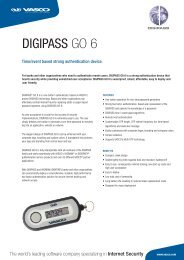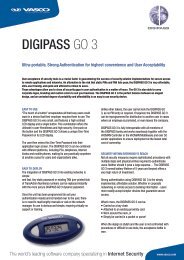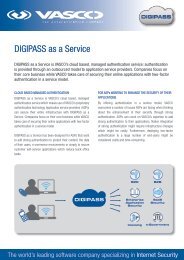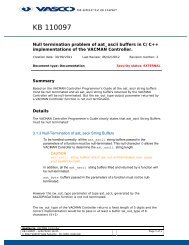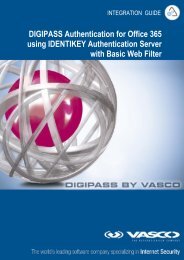Digipass Plug-In for SBR Administrator Reference - Vasco
Digipass Plug-In for SBR Administrator Reference - Vasco
Digipass Plug-In for SBR Administrator Reference - Vasco
You also want an ePaper? Increase the reach of your titles
YUMPU automatically turns print PDFs into web optimized ePapers that Google loves.
<strong>Digipass</strong> <strong>Plug</strong>-<strong>In</strong> <strong>for</strong> <strong>SBR</strong> <strong>Administrator</strong> <strong>Reference</strong> Backup and Recovery<br />
6.2.2.5 Rebuild <strong>SBR</strong> <strong>Plug</strong>-<strong>In</strong>, Copy Database<br />
This procedure will be required where multiple <strong>SBR</strong> <strong>Plug</strong>-<strong>In</strong>s are synchronizing with each other<br />
and one <strong>SBR</strong> <strong>Plug</strong>-<strong>In</strong>, together with its database, is lost. The instructions below assume one<br />
functional <strong>SBR</strong> <strong>Plug</strong>-<strong>In</strong> (SVR-1) with an up-to-date database, and a server on which an <strong>SBR</strong><br />
<strong>Plug</strong>-<strong>In</strong> must be rebuilt (SVR-2) and its database copied from the other <strong>SBR</strong> <strong>Plug</strong>-<strong>In</strong>.<br />
1. Rebuild SVR-2 with your operating system SOE, using the same IP address as be<strong>for</strong>e,<br />
2. Retrieve your backup copy of the dpsbrauth.xml file.<br />
3. Reinstall <strong>Digipass</strong> <strong>Plug</strong>-<strong>In</strong> <strong>for</strong> <strong>SBR</strong> on the server. The same settings as those chosen in<br />
the previous installation should be selected. Note: on Active Directory or an ODBC<br />
database, the This is not the first <strong>SBR</strong> <strong>Plug</strong>-<strong>In</strong> to be installed checkbox on the<br />
Prerequisites screen should be ticked.<br />
4. Tick the Use an evaluation license checkbox (the existing <strong>Digipass</strong> data in the data<br />
store contains all necessary licensing in<strong>for</strong>mation, which will be retrieved when the<br />
<strong>SBR</strong> <strong>Plug</strong>-<strong>In</strong> is operational).<br />
5. At the end of the installation, you will be prompted to select a license activation<br />
method. Select Just Continue.<br />
Be<strong>for</strong>e you restart SVR-2, carry out the following:<br />
6. Restore the backup copy of the configuration file dpsbrauth.xml into the same<br />
directory.<br />
7. Restore any customized files <strong>for</strong> the web sites (see 9.1 Customizing the Web Sites<br />
and 6.1.2 Web Sites <strong>for</strong> more in<strong>for</strong>mation).<br />
8. On SVR-1, stop the Steel-Belted RADIUS service.<br />
9. Take a complete copy of the database used by the <strong>SBR</strong> <strong>Plug</strong>-<strong>In</strong> on SVR-1. If you are<br />
using the embedded PostgreSQL database, see 6.1.6.3 Backup of Embedded<br />
Database <strong>for</strong> instructions.<br />
10. Delete the synchronization queue file(s) on SVR-1 <strong>for</strong> SVR-2.<br />
11. The Steel-Belted RADIUS service on SVR-1 may be restarted now if needed.<br />
12. Completely overwrite the database used by the <strong>SBR</strong> <strong>Plug</strong>-<strong>In</strong> on SVR-2 with the copy<br />
from SVR-1. If you are using the embedded PostgreSQL database:<br />
© 2006 VASCO Data Security <strong>In</strong>c. 80





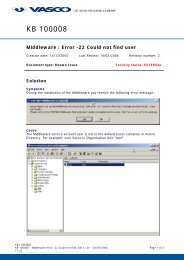

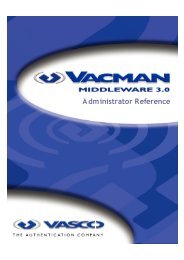
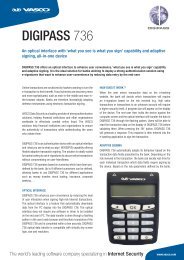
![KB [100006] - Vasco](https://img.yumpu.com/12539350/1/184x260/kb-100006-vasco.jpg?quality=85)

